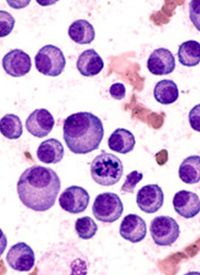Daratumumab Plus Induction Therapy Reduces Stem Cell Yield in Multiple Myeloma
The addition of daratumumab to frontline induction therapy prior to peripheral blood stem cell collection reduced the number of patients with newly diagnosed multiple myeloma who were able to meet their stem cell collection goals on first attempt.
Daratumumab Plus Induction Therapy in
Multiple Myeloma | Image Credit:
© David A Litman - stock.adobe.com

The addition of daratumumab (Darzalex) to frontline induction therapy prior to peripheral blood stem cell collection reduced the number of patients with newly diagnosed multiple myeloma who were able to meet their stem cell collection goals on first attempt, according to findings from a study that were presented at the 2023 EHA Congress.1 This regimen also increased the use of the hematopoietic stem cell mobilizer plerixafor in this population.
Overall, 93% of patients met the stem cell collection goal after mobilization therapy, however, 7% and 3% of patients needed a second and third mobilization attempt, respectively. The investigators noted that 3 factors were associated with a lower rate of collection goal after the first mobilization attempt. These included baseline plasmocytoma (P = .028), lower premobilization therapy level of neutrophils (P = .021), and cyclophosphamide (CTX) dose split over 2 days (P = .003).
Francesca Fazio, MD, PhD, a hematologist in the Department of Translational and Precision Medicine at Sapienza University in Rome, Italy, wrote that seventy-eight patients with newly diagnosed multiple myeloma were retrospectively evaluated at 12 hematology centers in Italy who underwent induction therapy. This regimen was comprised of daratumumab, bortezomib (Velcade), thalidomide, and dexamethasone (D-VTD). Following induction therapy, mobilization therapy was initiated per institutional guidelines. The primary end point of the study was to evaluate the impact of daratumumab-based induction therapy on first attempt peripheral blood stem cell collection.
Historically, adding daratumumab to induction therapy led to improved outcomes, and improved depth and duration of response, for patients with newly diagnosed multiple myeloma. Recent studies reported a potential reduction in stem cell yields in patients who were exposed to daratumumab prior to stem cell mobilization, the investigators wrote.2
The median age of patients was 60 years (range, 54-64), 64% were male, and 49% of patients had stage I disease, and 37% were stage II, according to the International Staging System (ISS) and the Revised-ISS, respectively. Forty-three percent of patients had either high-risk cytogenicity, standard risk cytogenicity (40%), or had cytogenetic risk information missing or not available (17%).
Forty-eight patients (94%) received 4 cycles of D-VTD as induction therapy after mobilization therapy. Four mobilization regimens were available and the most common regimens administered were cyclophosphamide (CTX) plus granulocyte colony stimulating factor (G-CSF; 89.8%) and CTX plus G-CSF and plerixafor (5.1%). Nearly 4% of patients received G-CSF only and 1.3% received G-CSF and plerixafor.
The time between last day of induction and the first day of mobilization therapy was a median of 31 days (range, 21-45) and 24 patients (30%) required plerixafor on demand, confirming that a higher use of plerixafor was necessary in the daratumumab-based induction therapy. Overall, the majority (55%) of patients required 1 day of CTX treatment and 45% required 2 days of CTX treatment.
Responses after induction therapy were positive, with 21% of patients experiencing a complete response (CR) and 51% experiencing a very good partial response. Fifteen percent had a partial response and 13% reported a stringent CR.
The investigators wrote that patients with a median lower premobilization therapy level of neutrophils (P = .013) and platelets (P = .035) had a significantly lower rate of collection goal after the first mobilization attempt. They attributed this to prolonged hematological toxicity after induction therapy.
These findings merit further investigation, with the investigators noting that a larger cohort of patients would be needed to confirm these results and to define a new mobilization therapy schedule that leads to adequate stem cell yields.
References
- Fazio F, Passuci M, Lisi C, et al. Effect of daratumumab on stem cell yields in patients with newly diagnosed multiple myeloma: report from the multiple myeloma Lazio group. Presented at: 2023 EHA Congress; June 8-15, 2023; Frankfurt, Germany. Poster P971.
- Hulin C, Offner F, Moreau P, et al. Stem cell yield and transplantation in transplant-eligible newly diagnosed multiple myeloma patients receiving daratumumab + bortezomib/thalidomide/dexamethasone in the phase 3 CASSIOPEIA study. Haematologica. 2021;106(8):2257-2260. doi:10.3324/haematol.2020.261842



